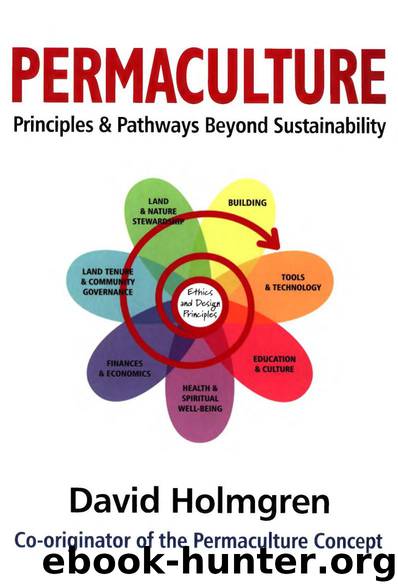Holmgren by principles & pathways

Author:principles & pathways [principles & pathways]
Language: ita
Format: epub
Published: 1601-01-01T00:00:00+00:00
we have spring bulbs that are also active well before the trees are in leaf. This system yields
less fruit than a traditional orchard of the same size but, as well as providing other yields,
it is more efficient in growing organic matter, using natural rainfall, recycling nutrients and
preventing leaching.
In milder coastal areas of Victoria a wide range of subtropical evergreen species, such as
avocado, citrus, macadamia and sapote, can be grown. This astounds visitors from the
northern hemisphere, where at similar latitudes winter cold precludes such species. In
these areas high-density evergreen food forests become a design option.
Fertility-loving and infertility-loving plants
The adaptation of plants to fertile (high-energy) and infertile (low-energy) soils also
illustrates subtle but fundamental patterns important for design. It is often assumed that
plants that are found naturally growing on infertile soils prefer these conditions. In fact, it
is their relative efficiency and therefore competitive advantage on poor soils that accounts
for their natural occurrence. Most plants grow better the higher the fertility, but only plants
evolved (or bred) to high-fertility soils are reasonably efficient in these situations.
Although our aim may be to increase productivity, matching plants and animals to suit
current conditions is also an important strategy. The hardy nature of local indigenous and
other Australian native plant species makes them ideal for providing shelter and other
functions in unirrigated and unfertilised soils. When we plant a new garden, the soil fertility
may support only a limited range of vegetables, but over time we can introduce more
demanding ones. The use of pioneer plants that grow in and improve poor soils is a strategy
which is considered further in Principle 12: Creatively Use and Respond to Change.
Plant and animal biomass as indicators of fertility
The relative amounts and types of plant and animal biomass in natural and managed
ecosystems can be used as a general indicator of mineral fertility. Although the Permaculture (and now mainstream scientific) view is that substantial perennial plant biomass is an important characteristic of sustainable agriculture, there are understandable reasons
why humans have tended to reduce woody and perennial biomass in managed systems.
Ecosystems with large amounts of woody plant biomass often predominate on infertile,
leached soils in high-rainfall areas, whereas the archetypical human habitats tended to be
drier regions with more grassy vegetation. These regions have vegetation with a higher
mineral content which supported large numbers of animals, and heavy seed-producing
grasses (parents of modem grains).
North American landscapes
The ecological and soil mineral balances in the short-grass prairie, tall-grass prairie and
eastern deciduous forests of the American mid-west were closely studied by William
Albrecht.21 He showed that the balance of minerals in the lower biomass and climatically
drier prairies favoured large herbivores, food crops, and thus people; while the deciduous
forests to the east with higher rainfall had more leached soils, less ideal for crops and
naturally supporting fewer large herbivores. These deciduous forests with abundant seed
crops of acorns, beechnuts and hickories that feed squirrels and turkeys are replaced on
lower-fertility soils by conifer forests. The conifer forests have abundant woody biomass
but few nutrients, large seeds or animals.
Download
This site does not store any files on its server. We only index and link to content provided by other sites. Please contact the content providers to delete copyright contents if any and email us, we'll remove relevant links or contents immediately.
International Integration of the Brazilian Economy by Elias C. Grivoyannis(91790)
The Radium Girls by Kate Moore(11930)
Turbulence by E. J. Noyes(7942)
Nudge - Improving Decisions about Health, Wealth, and Happiness by Thaler Sunstein(7622)
The Black Swan by Nassim Nicholas Taleb(7016)
Rich Dad Poor Dad by Robert T. Kiyosaki(6413)
Pioneering Portfolio Management by David F. Swensen(6229)
Man-made Catastrophes and Risk Information Concealment by Dmitry Chernov & Didier Sornette(5926)
Zero to One by Peter Thiel(5691)
Secrecy World by Jake Bernstein(4652)
Millionaire: The Philanderer, Gambler, and Duelist Who Invented Modern Finance by Janet Gleeson(4386)
The Age of Surveillance Capitalism by Shoshana Zuboff(4216)
Skin in the Game by Nassim Nicholas Taleb(4165)
Bullshit Jobs by David Graeber(4101)
The Money Culture by Michael Lewis(4083)
Skin in the Game: Hidden Asymmetries in Daily Life by Nassim Nicholas Taleb(3935)
The Dhandho Investor by Mohnish Pabrai(3705)
The Wisdom of Finance by Mihir Desai(3658)
Blockchain Basics by Daniel Drescher(3511)
